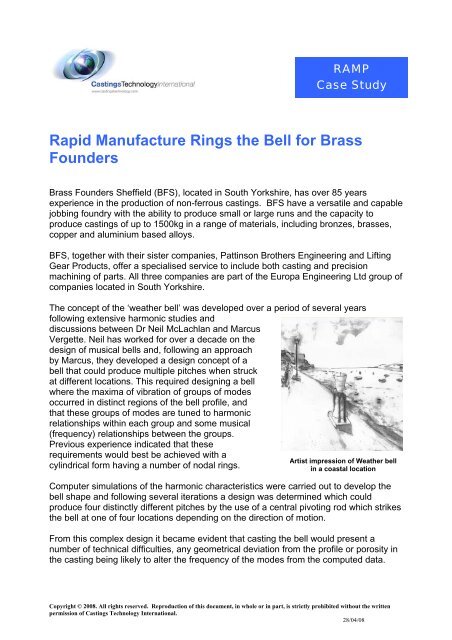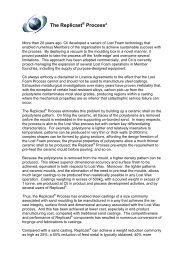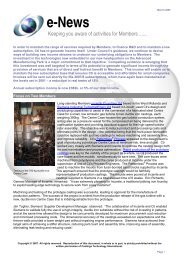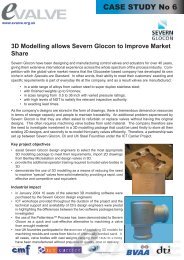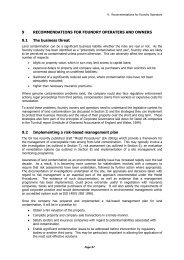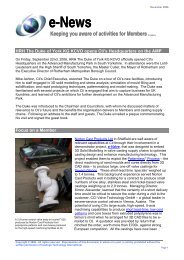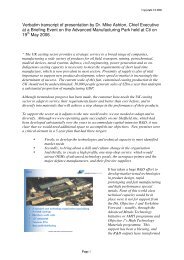Rapid Manufacture Rings the Bell for Brass Founders - Castings ...
Rapid Manufacture Rings the Bell for Brass Founders - Castings ...
Rapid Manufacture Rings the Bell for Brass Founders - Castings ...
Create successful ePaper yourself
Turn your PDF publications into a flip-book with our unique Google optimized e-Paper software.
RAMP<br />
Case Study<br />
<strong>Rapid</strong> <strong>Manufacture</strong> <strong>Rings</strong> <strong>the</strong> <strong>Bell</strong> <strong>for</strong> <strong>Brass</strong><br />
<strong>Founders</strong><br />
<strong>Brass</strong> <strong>Founders</strong> Sheffield (BFS), located in South Yorkshire, has over 85 years<br />
experience in <strong>the</strong> production of non-ferrous castings. BFS have a versatile and capable<br />
jobbing foundry with <strong>the</strong> ability to produce small or large runs and <strong>the</strong> capacity to<br />
produce castings of up to 1500kg in a range of materials, including bronzes, brasses,<br />
copper and aluminium based alloys.<br />
BFS, toge<strong>the</strong>r with <strong>the</strong>ir sister companies, Pattinson Bro<strong>the</strong>rs Engineering and Lifting<br />
Gear Products, offer a specialised service to include both casting and precision<br />
machining of parts. All three companies are part of <strong>the</strong> Europa Engineering Ltd group of<br />
companies located in South Yorkshire.<br />
The concept of <strong>the</strong> ‘wea<strong>the</strong>r bell’ was developed over a period of several years<br />
following extensive harmonic studies and<br />
discussions between Dr Neil McLachlan and Marcus<br />
Vergette. Neil has worked <strong>for</strong> over a decade on <strong>the</strong><br />
design of musical bells and, following an approach<br />
by Marcus, <strong>the</strong>y developed a design concept of a<br />
bell that could produce multiple pitches when struck<br />
at different locations. This required designing a bell<br />
where <strong>the</strong> maxima of vibration of groups of modes<br />
occurred in distinct regions of <strong>the</strong> bell profile, and<br />
that <strong>the</strong>se groups of modes are tuned to harmonic<br />
relationships within each group and some musical<br />
(frequency) relationships between <strong>the</strong> groups.<br />
Previous experience indicated that <strong>the</strong>se<br />
requirements would best be achieved with a<br />
cylindrical <strong>for</strong>m having a number of nodal rings.<br />
Artist impression of Wea<strong>the</strong>r bell<br />
in a coastal location<br />
Computer simulations of <strong>the</strong> harmonic characteristics were carried out to develop <strong>the</strong><br />
bell shape and following several iterations a design was determined which could<br />
produce four distinctly different pitches by <strong>the</strong> use of a central pivoting rod which strikes<br />
<strong>the</strong> bell at one of four locations depending on <strong>the</strong> direction of motion.<br />
From this complex design it became evident that casting <strong>the</strong> bell would present a<br />
number of technical difficulties, any geometrical deviation from <strong>the</strong> profile or porosity in<br />
<strong>the</strong> casting being likely to alter <strong>the</strong> frequency of <strong>the</strong> modes from <strong>the</strong> computed data.<br />
Copyright © 2008. All rights reserved. Reproduction of this document, in whole or in part, is strictly prohibited without <strong>the</strong> written<br />
permission of <strong>Castings</strong> Technology International.<br />
28/04/08
BFS have always been a <strong>for</strong>ward thinking company, utilising both new and traditional<br />
manufacturing processes to meet customer demands, and with <strong>the</strong> requirements to<br />
design a manufacturing route <strong>for</strong> this large specialised bronze ‘wea<strong>the</strong>r bell’ came <strong>the</strong><br />
need <strong>for</strong> some new approach to casting technology. As BFS have had a long<br />
association with Cti, it was a natural step to enlist <strong>the</strong>ir help in <strong>the</strong> manufacturing<br />
process <strong>for</strong> <strong>the</strong> casting.<br />
From <strong>the</strong> requirements to produce a ‘one-off’ item and<br />
<strong>for</strong> this to be of a highly accurate <strong>for</strong>m, <strong>the</strong> process of<br />
direct mould manufacture using Cti’s machined layered<br />
Patternless ® approach was determined to be <strong>the</strong><br />
optimum technique to be used. The initial configuration<br />
of a single, double hour-glass shape was developed<br />
into two individual cast pieces with a central fixing<br />
casting incorporating <strong>the</strong> striker assembly.<br />
BFS supplied <strong>the</strong> drawing in<strong>for</strong>mation from which Cti<br />
developed <strong>the</strong> model, mould manufacturing strategy,<br />
and feeding and gating process. These were developed<br />
to suit <strong>the</strong> casting capabilities of BFS and <strong>the</strong> moulds<br />
were prepared at Cti and returned to BFS <strong>for</strong> casting.<br />
Casting into a Patternless ® mould<br />
The material specified <strong>for</strong> <strong>the</strong> bell was ‘Admiralty <strong>Brass</strong>’, nominally an 80% copper,<br />
20% tin alloy which has long been used as <strong>the</strong> standard naval bell material.<br />
BFS produced <strong>the</strong> bell castings and finishing was carried out at <strong>the</strong>ir sister company,<br />
Pattinson Bro<strong>the</strong>rs Engineering.<br />
The bell will be located at Appledore in Devon, with ongoing<br />
discussions of a fur<strong>the</strong>r 11 bells to be manufactured and<br />
located at coastal positions around <strong>the</strong> British Isles.<br />
Barrie McCabe, Managing Director of <strong>Brass</strong> <strong>Founders</strong><br />
Sheffield says that “<strong>the</strong> ability of BFS to take advantage of<br />
<strong>the</strong> new rapid manufacturing technology available at Cti in<br />
producing such demanding products and to exacting<br />
dimensional tolerances has provided BFS with unequalled<br />
support in meeting specialised customer requirements. The<br />
business potential of such items is expected to exceed<br />
£250k within <strong>the</strong> <strong>for</strong>eseeable future and builds on <strong>the</strong><br />
technical expertise <strong>the</strong> company can offer clients”.<br />
Finishing of <strong>Bell</strong><br />
The support provided to <strong>Brass</strong> <strong>Founders</strong> was made possible through <strong>the</strong><br />
<strong>Rapid</strong> Manufacturing Capacity Building Programme (RAMP) funded by<br />
Yorkshire Forward and <strong>the</strong> European Union through <strong>the</strong> Objective 1<br />
Programme.<br />
Copyright © 2008. All rights reserved. Reproduction of this document, in whole or in part, is strictly prohibited without <strong>the</strong> written<br />
permission of <strong>Castings</strong> Technology International.<br />
28/04/08


